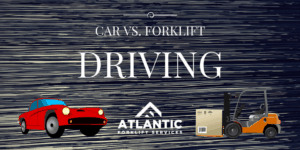 Four tires, a seat and a steering wheel, how much different could driving a forklift be from driving a car?
Four tires, a seat and a steering wheel, how much different could driving a forklift be from driving a car?
It’s different. We’re about to send a newbie through fork lift operator training, a process we’ll document here, so we’ll get an insider’s view of just what the training is all about and how difficult it is. This is someone with next-to-no warehouse experience, so at the very least it will be entertaining.
Anyway, driving a forklift is different from a car. Cars steer from the front wheels, where a forklift steers with the rear, allowing it to make 360-degree moves in tight quarters.
Having a full understanding of the differences between a forklift and a conventional automobile is the basis for operating a lift safely.
Forklifts operate in tight spaces. An experienced forklift operator knows that a lift is not as responsive as a car, it doesn’t stop quickly, or swerve especially well.
Operating a lift outdoors has its own set of concerns, too. Uneven surfaces require certain steps by the operator to prevent the load from slipping off or equally as bad, the forklift itself from tipping over. Keep the load on the high side.
Rarely, in a car, are you hauling a load that would block your view- and if you are we should probably talk because you may need a forklift. You also spend a lot of time traveling backwards in a forklift. That has its own set of safety procedures.
The biggest similarity between a forklift and a car is the seatbelt and its function. It’s designed to keep you inside the vehicle in the event of an accident. The seatbelt is your friend. Use it.
We’ll keep you updated as our friend learns how to operate a forklift- and in the meantime, if you have any questions about forklift training or safety procedures, don’t hesitate to contact us. We’ve got the expertise to answer your questions, and we really don’t want to see anyone get hurt.
